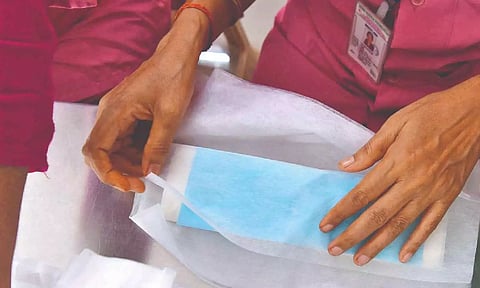

WASHINGTON: When Super Cyclone Amphan hit India’s coast in 2020, 28-year-old Suchita Jana, along with her family, moved to a government shelter where she found herself among the 800odd people taking refuge at the camp. While she stayed at the cramped schoolturned-shelter for only 20 days, her ordeal lasted for months. After the cyclone, Jana found out that she had developed a vaginal infection. “The infection lasted for 6-7 months. I had a severe burning sensation and a strong odour which was very uncomfortable to bear,” said Jana, a resident of Khetramohan Pur village in the Pathar Pratima block of South 24 Parganas district, which lies along the coast of West Bengal.
The shelter, where Jana stayed with her family, had just four toilets for the hundreds of people who sought protection from the cyclone and both men and women used the same washrooms.
“We would need to stand for hours in line to be able to use the toilet which was very filthy,” Jana said, adding that access to water was a huge issue because “there was just one tubewell for all the people at the shelter.” During the cyclone, when Jana had her periods, she went on to use pieces of cloth for days at a time because she could not get sanitary napkins and there was no place to wash or dry the material at the shelter.
“We used to first stand in line for water and then for using the toilets. It used to take hours of our day.” When months of medication prescribed at the block hospital didn’t help Jana, she consulted doctors in the state’s capital, Kolkata — where she would arrive after a six-hour journey crossing multiple rivers.
Like Jana, Mamu Das, 32, of Nagaon district in Assam, had to face conditions of inadequate sanitation facilities and poor access to menstrual products when floods wreaked havoc across several districts last year. When Das’ family lost their livelihoods due to the floods, it impacted her ability to afford sanitary napkins. “I used to take sanitary napkins from shopkeepers as borrowings [a loan that would be paid for later].” Natural disasters like floods and cyclones lead to large-scale displacements. The displaced communities include women whose menstrual health takes a back seat during these calamities.
“At health camps during natural disasters, chronic diseases take priority so women usually don’t bring up issues related to menstrual health management,” said Sobhan Mukherjee, a menstrual health activist. Women face numerous challenges at shelter camps like access to toilets, sanitary napkins, increased risk of infections etc.
“Due to the stress of the calamity, women’s menstrual cycles also stop suddenly. Sometimes, they end up skipping their periods for months,” said Dr Basab Mukherjee, vice president of the Bengal Obstetric & Gynaecological Society. “The rate of urinary tract infections, vaginal infections, etc., generally increases after disasters like cyclones and floods because women are not able to maintain proper menstrual hygiene,” he told DW. Climate change may increase risks for women by shifting the timing of menarche, or first menstruation, according to a study published in the International Journal of Environmental Research and Public Health. A United Nations report last year highlighted that “extreme weather events due to climate change disproportionately affect women and girls and their ability to perform their everyday tasks.” “In Indian communities, it is usually women who are left behind in climate-vulnerable zones as men leave in search of jobs. The women deal with the daily logistics which are greatly impacted by climate change,” said Megha Desai of Desai Foundation, an NGO that works for menstrual equity.
In 2020 and 2021, floods and cyclones, which are influenced by the southwest and northeast monsoon seasons, were the main reasons for disaster displacement. The eastern coast of India is highly prone to tropical cyclones. However, in recent years they have grown to become more intense. Scientists have warned the reason behind this increased intensity is climate change.